Abstract
On the basis of the published nucleotide sequences of the genes that code for the heat-labile toxin LTh and the heat-stable toxins STaI and STaII of human enterotoxigenic Escherichia coli, a 34-mer and two 33-mer oligonucleotide probes were synthesized. To compare their relative efficacies in the detection and differentiation of enterotoxigenic E. coli, a colony hybridization technique using these probes and a GM1 ganglioside enzyme-linked immunosorbent assay using monoclonal anti-LT and anti-ST antibodies were used with 76 strains of E. coli with known enterotoxin profiles. For further evaluation of probe specificity, the enterotoxigenic bacteria Vibrio cholerae O1 and non-O1 and Yersinia enterocolitica were examined with the colony hybridization technique. The sensitivity of colony hybridization compared favorably with that of GM1 ganglioside enzyme-linked immunosorbent assay, and the two assays showed a high level of concordance in specific detection and differentiation of E. coli with various enterotoxin profiles (kappa = 0.906, P less than 0.00001). The probes did not hybridize with DNAs from strains of V. cholerae O1 or non-O1 or Y. enterocolitica.
Full text
PDF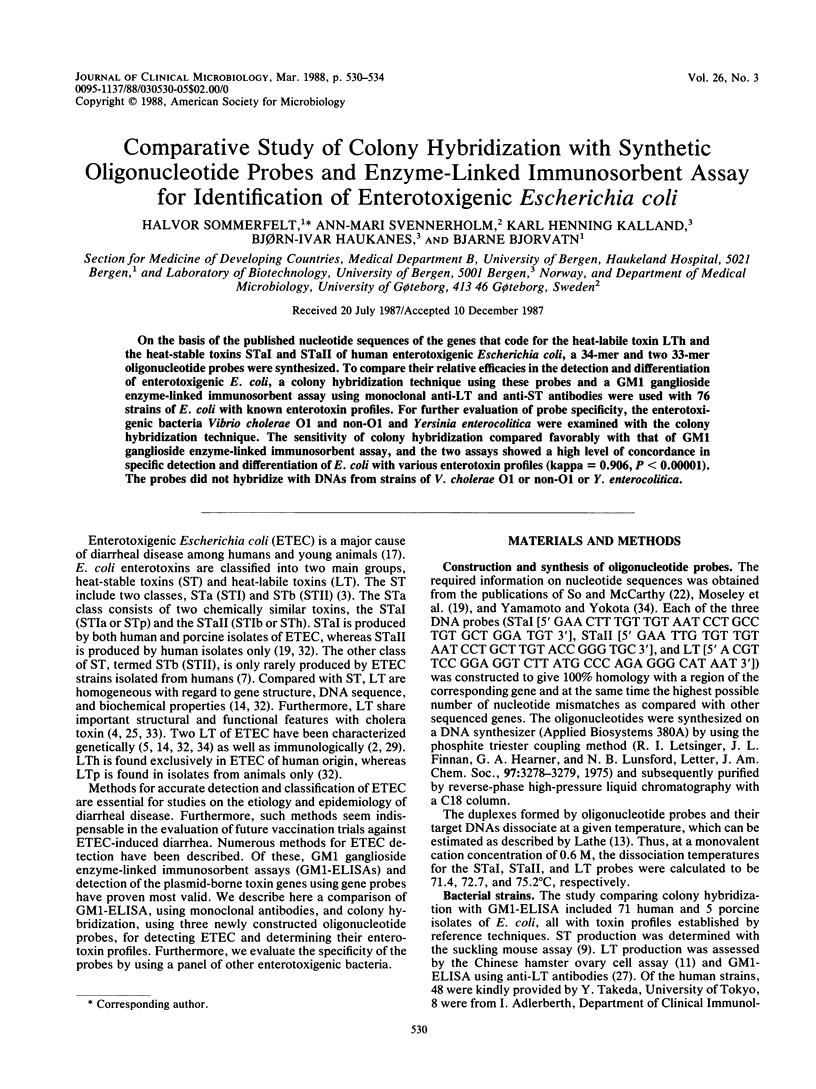
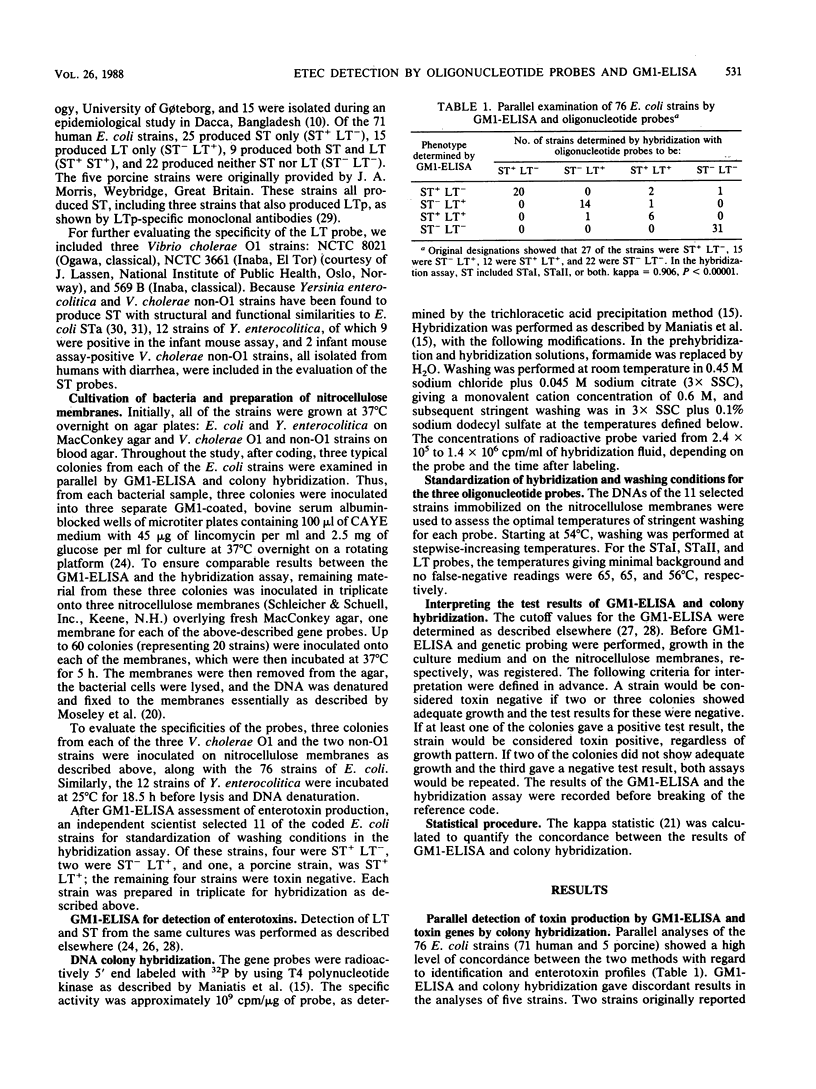
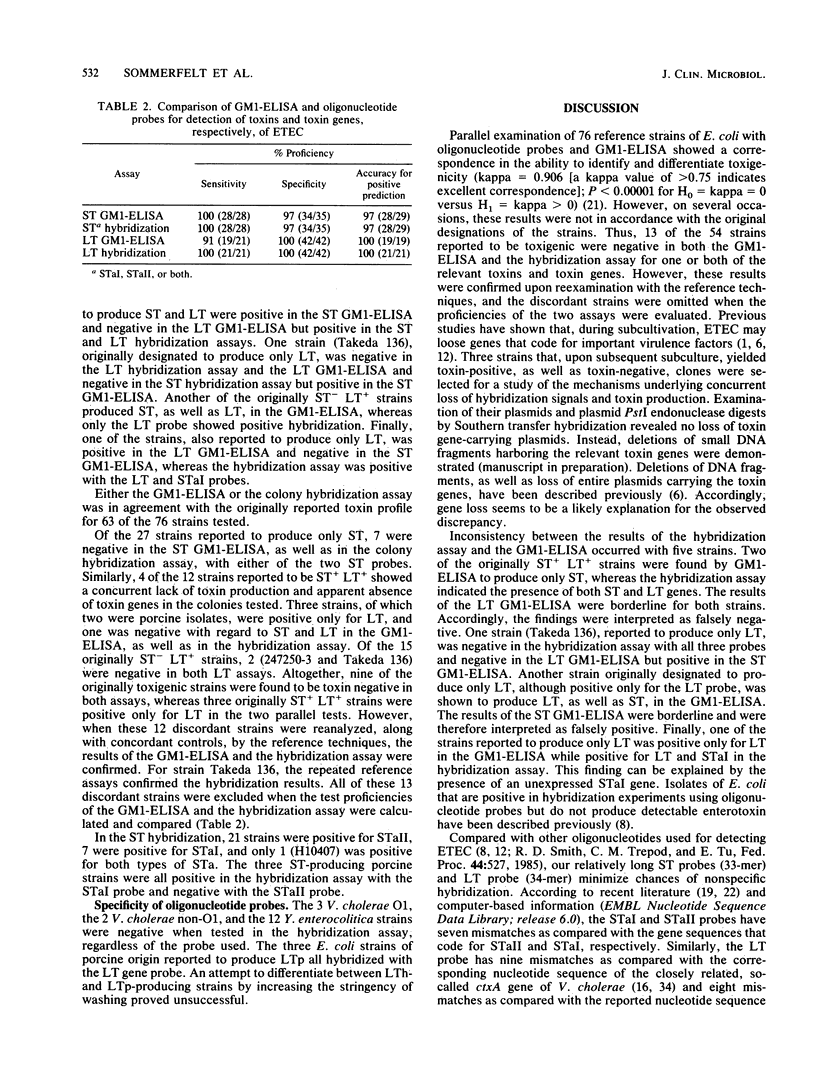
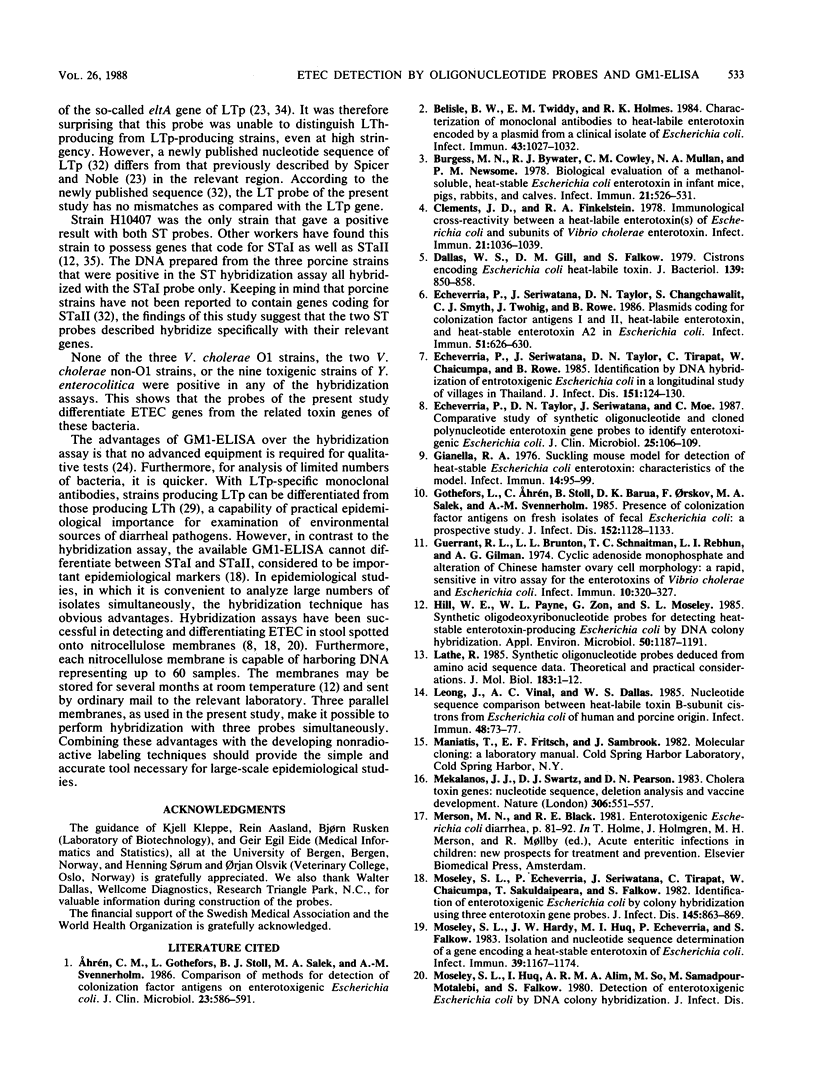
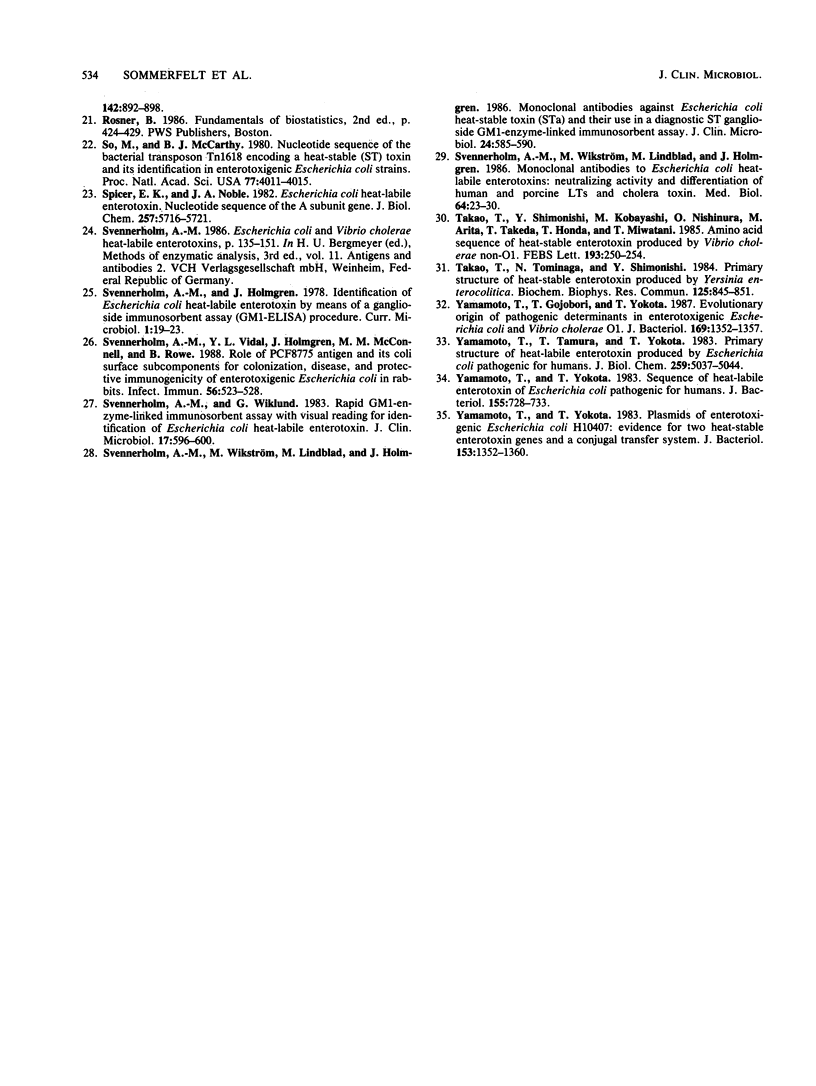
Selected References
These references are in PubMed. This may not be the complete list of references from this article.
- Ahrén C. M., Gothefors L., Stoll B. J., Salek M. A., Svennerholm A. M. Comparison of methods for detection of colonization factor antigens on enterotoxigenic Escherichia coli. J Clin Microbiol. 1986 Mar;23(3):586–591. doi: 10.1128/jcm.23.3.586-591.1986. [DOI] [PMC free article] [PubMed] [Google Scholar]
- Belisle B. W., Twiddy E. M., Holmes R. K. Characterization of monoclonal antibodies to heat-labile enterotoxin encoded by a plasmid from a clinical isolate of Escherichia coli. Infect Immun. 1984 Mar;43(3):1027–1032. doi: 10.1128/iai.43.3.1027-1032.1984. [DOI] [PMC free article] [PubMed] [Google Scholar]
- Burgess M. N., Bywater R. J., Cowley C. M., Mullan N. A., Newsome P. M. Biological evaluation of a methanol-soluble, heat-stable Escherichia coli enterotoxin in infant mice, pigs, rabbits, and calves. Infect Immun. 1978 Aug;21(2):526–531. doi: 10.1128/iai.21.2.526-531.1978. [DOI] [PMC free article] [PubMed] [Google Scholar]
- Clements J. D., Finkelstein R. A. Immunological cross-reactivity between a heat-labile enterotoxin(s) of Escherichia coli and subunits of Vibrio cholerae enterotoxin. Infect Immun. 1978 Sep;21(3):1036–1039. doi: 10.1128/iai.21.3.1036-1039.1978. [DOI] [PMC free article] [PubMed] [Google Scholar]
- Dallas W. S., Gill D. M., Falkow S. Cistrons encoding Escherichia coli heat-labile toxin. J Bacteriol. 1979 Sep;139(3):850–858. doi: 10.1128/jb.139.3.850-858.1979. [DOI] [PMC free article] [PubMed] [Google Scholar]
- Echeverria P., Seriwatana J., Taylor D. N., Changchawalit S., Smyth C. J., Twohig J., Rowe B. Plasmids coding for colonization factor antigens I and II, heat-labile enterotoxin, and heat-stable enterotoxin A2 in Escherichia coli. Infect Immun. 1986 Feb;51(2):626–630. doi: 10.1128/iai.51.2.626-630.1986. [DOI] [PMC free article] [PubMed] [Google Scholar]
- Echeverria P., Seriwatana J., Taylor D. N., Tirapat C., Chaicumpa W., Rowe B. Identification by DNA hybridization of enterotoxigenic Escherichia coli in a longitudinal study of villages in Thailand. J Infect Dis. 1985 Jan;151(1):124–130. doi: 10.1093/infdis/151.1.124. [DOI] [PubMed] [Google Scholar]
- Echeverria P., Taylor D. N., Seriwatana J., Moe C. Comparative study of synthetic oligonucleotide and cloned polynucleotide enterotoxin gene probes to identify enterotoxigenic Escherichia coli. J Clin Microbiol. 1987 Jan;25(1):106–109. doi: 10.1128/jcm.25.1.106-109.1987. [DOI] [PMC free article] [PubMed] [Google Scholar]
- Giannella R. A. Suckling mouse model for detection of heat-stable Escherichia coli enterotoxin: characteristics of the model. Infect Immun. 1976 Jul;14(1):95–99. doi: 10.1128/iai.14.1.95-99.1976. [DOI] [PMC free article] [PubMed] [Google Scholar]
- Gothefors L., Ahrén C., Stoll B., Barua D. K., Orskov F., Salek M. A., Svennerholm A. M. Presence of colonization factor antigens on fresh isolates of fecal Escherichia coli: a prospective study. J Infect Dis. 1985 Dec;152(6):1128–1133. doi: 10.1093/infdis/152.6.1128. [DOI] [PubMed] [Google Scholar]
- Guerrant R. L., Brunton L. L., Schnaitman T. C., Rebhun L. I., Gilman A. G. Cyclic adenosine monophosphate and alteration of Chinese hamster ovary cell morphology: a rapid, sensitive in vitro assay for the enterotoxins of Vibrio cholerae and Escherichia coli. Infect Immun. 1974 Aug;10(2):320–327. doi: 10.1128/iai.10.2.320-327.1974. [DOI] [PMC free article] [PubMed] [Google Scholar]
- Hill W. E., Payne W. L., Zon G., Moseley S. L. Synthetic oligodeoxyribonucleotide probes for detecting heat-stable enterotoxin-producing Escherichia coli by DNA colony hybridization. Appl Environ Microbiol. 1985 Nov;50(5):1187–1191. doi: 10.1128/aem.50.5.1187-1191.1985. [DOI] [PMC free article] [PubMed] [Google Scholar]
- Lathe R. Synthetic oligonucleotide probes deduced from amino acid sequence data. Theoretical and practical considerations. J Mol Biol. 1985 May 5;183(1):1–12. doi: 10.1016/0022-2836(85)90276-1. [DOI] [PubMed] [Google Scholar]
- Leong J., Vinal A. C., Dallas W. S. Nucleotide sequence comparison between heat-labile toxin B-subunit cistrons from Escherichia coli of human and porcine origin. Infect Immun. 1985 Apr;48(1):73–77. doi: 10.1128/iai.48.1.73-77.1985. [DOI] [PMC free article] [PubMed] [Google Scholar]
- Mekalanos J. J., Swartz D. J., Pearson G. D., Harford N., Groyne F., de Wilde M. Cholera toxin genes: nucleotide sequence, deletion analysis and vaccine development. Nature. 1983 Dec 8;306(5943):551–557. doi: 10.1038/306551a0. [DOI] [PubMed] [Google Scholar]
- Moseley S. L., Echeverria P., Seriwatana J., Tirapat C., Chaicumpa W., Sakuldaipeara T., Falkow S. Identification of enterotoxigenic Escherichia coli by colony hybridization using three enterotoxin gene probes. J Infect Dis. 1982 Jun;145(6):863–869. doi: 10.1093/infdis/145.6.863. [DOI] [PubMed] [Google Scholar]
- Moseley S. L., Hardy J. W., Hug M. I., Echeverria P., Falkow S. Isolation and nucleotide sequence determination of a gene encoding a heat-stable enterotoxin of Escherichia coli. Infect Immun. 1983 Mar;39(3):1167–1174. doi: 10.1128/iai.39.3.1167-1174.1983. [DOI] [PMC free article] [PubMed] [Google Scholar]
- So M., McCarthy B. J. Nucleotide sequence of the bacterial transposon Tn1681 encoding a heat-stable (ST) toxin and its identification in enterotoxigenic Escherichia coli strains. Proc Natl Acad Sci U S A. 1980 Jul;77(7):4011–4015. doi: 10.1073/pnas.77.7.4011. [DOI] [PMC free article] [PubMed] [Google Scholar]
- Spicer E. K., Noble J. A. Escherichia coli heat-labile enterotoxin. Nucleotide sequence of the A subunit gene. J Biol Chem. 1982 May 25;257(10):5716–5721. [PubMed] [Google Scholar]
- Svennerholm A. M., Vidal Y. L., Holmgren J., McConnell M. M., Rowe B. Role of PCF8775 antigen and its coli surface subcomponents for colonization, disease, and protective immunogenicity of enterotoxigenic Escherichia coli in rabbits. Infect Immun. 1988 Feb;56(2):523–528. doi: 10.1128/iai.56.2.523-528.1988. [DOI] [PMC free article] [PubMed] [Google Scholar]
- Svennerholm A. M., Wiklund G. Rapid GM1-enzyme-linked immunosorbent assay with visual reading for identification of Escherichia coli heat-labile enterotoxin. J Clin Microbiol. 1983 Apr;17(4):596–600. doi: 10.1128/jcm.17.4.596-600.1983. [DOI] [PMC free article] [PubMed] [Google Scholar]
- Svennerholm A. M., Wikström M., Lindblad M., Holmgren J. Monoclonal antibodies against Escherichia coli heat-stable toxin (STa) and their use in a diagnostic ST ganglioside GM1-enzyme-linked immunosorbent assay. J Clin Microbiol. 1986 Oct;24(4):585–590. doi: 10.1128/jcm.24.4.585-590.1986. [DOI] [PMC free article] [PubMed] [Google Scholar]
- Svennerholm A. M., Wikström M., Lindblad M., Holmgren J. Monoclonal antibodies to Escherichia coli heat-labile enterotoxins: neutralising activity and differentiation of human and porcine LTs and cholera toxin. Med Biol. 1986;64(1):23–30. [PubMed] [Google Scholar]
- Takao T., Shimonishi Y., Kobayashi M., Nishimura O., Arita M., Takeda T., Honda T., Miwatani T. Amino acid sequence of heat-stable enterotoxin produced by Vibrio cholerae non-01. FEBS Lett. 1985 Dec 2;193(2):250–254. doi: 10.1016/0014-5793(85)80163-0. [DOI] [PubMed] [Google Scholar]
- Takao T., Tominaga N., Shimonishi Y., Hara S., Inoue T., Miyama A. Primary structure of heat-stable enterotoxin produced by Yersinia enterocolitica. Biochem Biophys Res Commun. 1984 Dec 28;125(3):845–851. doi: 10.1016/0006-291x(84)91360-3. [DOI] [PubMed] [Google Scholar]
- Yamamoto T., Gojobori T., Yokota T. Evolutionary origin of pathogenic determinants in enterotoxigenic Escherichia coli and Vibrio cholerae O1. J Bacteriol. 1987 Mar;169(3):1352–1357. doi: 10.1128/jb.169.3.1352-1357.1987. [DOI] [PMC free article] [PubMed] [Google Scholar]
- Yamamoto T., Tamura T., Yokota T. Primary structure of heat-labile enterotoxin produced by Escherichia coli pathogenic for humans. J Biol Chem. 1984 Apr 25;259(8):5037–5044. [PubMed] [Google Scholar]
- Yamamoto T., Yokota T. Plasmids of enterotoxigenic Escherichia coli H10407: evidence for two heat-stable enterotoxin genes and a conjugal transfer system. J Bacteriol. 1983 Mar;153(3):1352–1360. doi: 10.1128/jb.153.3.1352-1360.1983. [DOI] [PMC free article] [PubMed] [Google Scholar]
- Yamamoto T., Yokota T. Sequence of heat-labile enterotoxin of Escherichia coli pathogenic for humans. J Bacteriol. 1983 Aug;155(2):728–733. doi: 10.1128/jb.155.2.728-733.1983. [DOI] [PMC free article] [PubMed] [Google Scholar]


